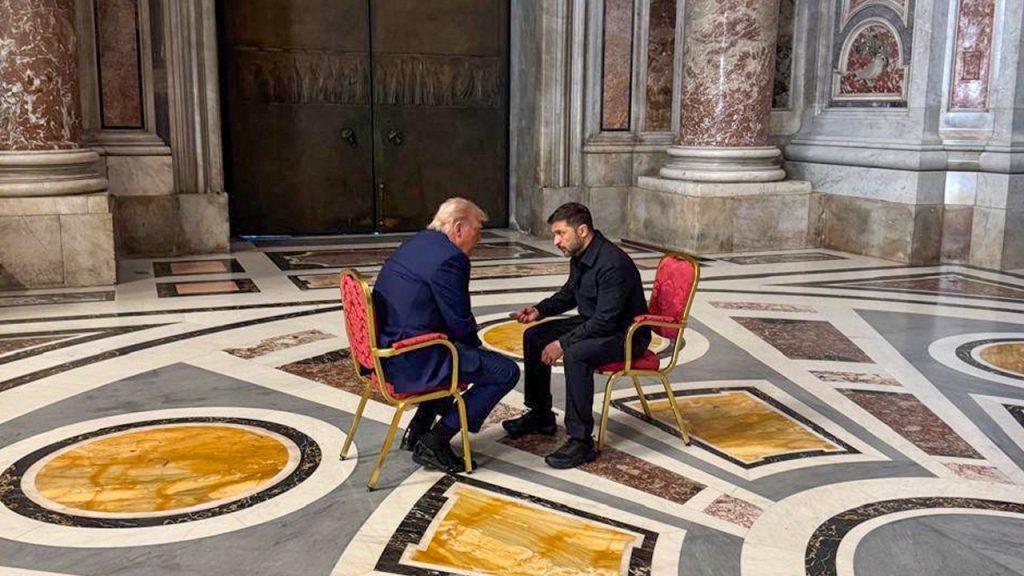In a recent town hall discussion, former President Donald Trump shared insights about his meeting with Ukrainian President Volodymyr Zelenskyy during the funeral of Pope Francis. This first face-to-face conversation since their contentious 2020 Oval Office meeting raised hopes for a renewed dialogue on peace and ongoing military support amid escalating tensions with Russia. Both leaders expressed optimism for a productive outcome, suggesting a potential turning point in the U.S.-Ukraine relations.
| Article Subheadings |
|---|
| 1) Overview of the Meeting |
| 2) Significance of the Papal Funeral Meeting |
| 3) Key Discussion Points |
| 4) Reactions from Both Leaders |
| 5) Implications for U.S. Foreign Policy |
Overview of the Meeting
The meeting between Donald Trump and Volodymyr Zelenskyy was notable as it took place during a somber occasion—the funeral of Pope Francis, a spiritual leader who advocated for peace. Their discussion lasted over an hour, marking a significant moment for both leaders as they sought common ground amidst turbulent geopolitical circumstances. Although the details of the conversation remain largely undisclosed, officials highlighted the “symbolic” nature of this face-to-face interaction. The meeting is perceived as an opportunity for greater cooperation regarding the intense conflict in Ukraine, which has seen increased aggression from Russia.
Significance of the Papal Funeral Meeting
The meeting’s backdrop—the funeral of a universally recognized figure—underscored its potential importance. Many view this as a moment where international leaders can reassess their priorities and strategies. The Vatican serves as a neutral ground for political conversations, allowing leaders to engage without the usual pressures of their respective offices. This particular meeting may open new channels for dialogue not just between the U.S. and Ukraine, but also involving other nations concerned about Russia’s military actions. By choosing this moment, Zelenskyy and Trump aimed to fuse the themes of grief and hope, showing solidarity in the face of adversity.
Key Discussion Points
During their conversation, Trump mentioned that they discussed Ukraine’s ongoing need for military support. “He told me that he needs more weapons, but he’s been saying that for three years,” Trump noted, reflecting on Zelenskyy’s consistent calls for assistance. This highlights the urgency and gravity of the military situation in Ukraine as it grapples with Russian advances. The discussion also touched on the potential need for a peace agreement, with Trump expressing skepticism about Russia’s intentions given their recent military actions despite diplomatic discussions.
Reactions from Both Leaders
Following the meeting, Zelenskyy took to social media to express hope for the outcomes of their discussion. He emphasized the importance of protecting the lives of Ukrainian citizens, advocating for a full ceasefire, and establishing a lasting peace to prevent future conflicts. His posts illustrated a blend of optimism and realism, recognizing the challenge ahead in negotiating peace. Trump’s comments also reflected a cautious optimism, suggesting that while he understood the need for diplomacy, he remained pragmatic about Russia’s unpredictability and the complexities involved in reaching an agreement.
Implications for U.S. Foreign Policy
This meeting has significant implications for U.S. foreign policy in Eastern Europe. With the demand for military aid highlighted, it signals a potential shift in how the U.S. approaches its relationship with Ukraine. The Biden administration has provided extensive assistance, but Trump’s commentary suggests even more robust support could be on the table if he returns to office. His willingness to discuss a more aggressive stance against Russia indicates a possible recalibration of U.S. foreign policy that could resonate across administrations. The upcoming elections could also influence how future U.S. leaders navigate this complex geopolitical chessboard.
| No. | Key Points |
|---|---|
| 1 | Former President Trump and Ukrainian President Zelenskyy met at Pope Francis’ funeral. |
| 2 | The meeting is viewed as symbolic and has potential for future dialogue. |
| 3 | Trump discussed military aid during the conversation, emphasizing Ukraine’s consistent requests. |
| 4 | Zelenskyy expressed hopes for a full ceasefire and lasting peace. |
| 5 | The conversation could reshape U.S. foreign policy toward Ukraine depending on political outcomes. |
Summary
The recent meeting between Donald Trump and Volodymyr Zelenskyy at the Vatican underscores a critical moment in international diplomacy regarding the ongoing conflict in Ukraine. While the specifics of their discussions remain largely under wraps, the very act of convening during a significant global event illustrates a commitment to dialogue and cooperation. As both leaders navigate their respective political landscapes, the implications of this meeting may reverberate through future U.S. foreign policy decisions and the broader geopolitical climate of Eastern Europe.
Frequently Asked Questions
Question: What was the main focus of the Trump-Zelenskyy meeting?
The primary focus of the meeting was to discuss military support for Ukraine amid ongoing tensions with Russia, along with broader peace negotiations.
Question: Why did the meeting take place during Pope Francis’ funeral?
The meeting occurred during a significant event, allowing leaders to engage in a neutral setting and emphasizing the importance of diplomacy for peace.
Question: What are the implications for U.S. foreign policy following this meeting?
The implications may include a stronger U.S. commitment to military support for Ukraine and a potential shift in foreign policy depending on forthcoming national elections.


